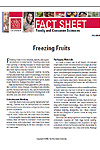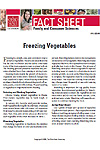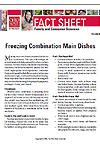Freezer Friendly Tips
Eating healthy takes a lot of effort, so I'm always looking for things that will save me time in the kitchen. One of the biggest timesavers is simple. I cook double and triple recipes, then freeze individual servings for later.
Of course, not everything can be frozen, so here's a little lesson on what freezing does to food and tips on how to freeze foods successfully.
What does freezing do?
Freezing stops microbes.
Freezing slows the movement of molecules, causing microbes to enter a dormant stage, preventing the growth of microorganisms that cause food spoilage and foodborne illness. Food frozen at 0 degrees Fahrenheit or colder will remain safe indefinitely, provided it was safe when initially frozen. Charts are available that offer suggestions of how long a food should be stored, but those charts are for food quality, not safety.
Make sure only to freeze foods that are in perfect condition. Freezing does not sterilize food or destroy the organisms that cause spoilage. Food that's been spoiling won't suddenly become fresh just by putting it in the freezer.
Freezing slows enzymes.
Enzymes promote chemical reactions, such as ripening in fruits. Enzyme activity won't harm frozen meats or fish, but fruits can turn brown while being frozen or thawed. Using antioxidants like citric acid (ok) or ascorbic acid (better) can keep light-colored fruits like apples, peaches or pears from discoloring.
To stop enzyme activity in vegetables, you should blanch them before freezing. Blanching is the process where vegetables are exposed to boiling water or steam for a brief period, and then the vegetable is rapidly cooled in ice water to prevent cooking. Make sure to follow blanching instructions precisely. Over-blanching can reduce the flavor, color and nutrients. Under blanching can stimulate enzyme activity and be worse than no blanching at all. For details on preparation and boiling water blanch times for common vegetables, we can recommend the two websites below. Simply click on the titles to take you there.
Ohio State University Extension
FREEZING FACT SHEETS
These are in Adobe PDF Format
Freezing Tips
- Oxidation is the act of exposing a substance to air. If air is left in contact with food, even frozen food, it can turn fats rancid. That's why you "burp" your plastic containers to get the most air out. Try and use the smallest container possible, so food is exposed to the least amount of air. Containers that are wide and shallow are better. Freezer bags are also excellent because you can squeeze the excess air out of them.
- You typically shouldn't freeze foods in the package they came in. The plastic wrap used on most meat allows air to permeate and will cause freezer burn.
- Freezer burn happens if food loses its moisture when frozen. Moisture is lost through damaged packaging or improper seals. Make sure all packages are tightly sealed to prevent moisture or surface crystals from evaporating. If food does suffer freezer burn, it doesn't make it unsafe, merely dry in spots. For quality reasons, you may have to discard food that has freezer burn or cut the freezer-burned portion away.
- Label food you freeze with the date you froze it. Use the rule of FIFO (First In First Out). The first batch of a particular food you freeze should be the first batch you take out and eat.
- Divide food into portions before freezing. You shouldn't thaw large portions and then re-freeze what you don't eat; the thawing and re-freezing can damage food quality and risk exposing you to foodborne illnesses.
- Cool hot foods before you put them in the freezer. If you put too many hot foods in the freezer at once, it can raise the temperature and slow down the freezing process, possibly affecting the quality and safety of the other foods. Mix the new food with other frozen products, and leave a little space around each container to allow cold air circulation. After the foods are frozen, you can group them together.
- Freezers run more efficiently when filled, they spend less energy cooling air. However, you want to leave a little space between items so the cold air can circulate and maintain the temperature.
- If your freezer has a 'quick-freeze' shelf, use it. The faster a food freezes, the better. Fast freezing prevents the undesirable and disruptive large ice crystals from forming because the molecules don't have time to form the typical six-sided snowflake.
- For best results, keep food frozen at 0 degrees Fahrenheit or lower to minimize ice crystal growth that happens when food temperatures fluctuate.
What freezes best?
Vegetables freeze better than meat, seafood or fruit. Casseroles tend to freeze well, as do many recipes with some sauce. Pasta and cooked rice are also good candidates for freezing as long as you slightly undercook them; that way they won't get too soggy when you reheat them.
What freezes worst?
High sodium foods. Salt lowers the freezing point of water, so foods that are high in sodium don't freeze as well. Foods high in fat don't do as well either, so trim off any excess fat on pork, chicken and steak before putting it in the freezer.
Sauces and gravies thickened with flour or cornstarch can separate and break down when frozen. If you want the best results, freeze the gravy unthickened and add thickener when you reheat it.
Fruits and vegetables with high water content or a delicate cell structure should also be avoided. The freezing process turns the water into ice, breaking apart the structure of the food. Watermelon and sliced tomatoes, with their high water content, tend to break apart and turn mushy when frozen and thawed.
Thawing Food
There are three safe ways to defrost food.
- In the refrigerator at 40 degrees Fahrenheit or lower.
- In the microwave immediately before cooking.
- In running cold water for very short periods of time.
If you thaw food in the microwave or under running cold water, you should cook it immediately after thawing.
Planning ahead is important. It takes approximately one day in the refrigerator thawing for every 5 pounds of weight. That means a 10-pound turkey will take two days to thaw, so prepare for special occasions accordingly.
Never re-freeze cooked food that has been thawed or partially thawed. Food can experience a noticeable loss of quality due to the moisture lost through defrosting. Raw foods that were frozen, such as meats or vegetables, can be re-frozen after they've been cooked, provided safe cooking procedures were followed.
If you have more questions about meat, poultry or egg products, you can call the toll-free USDA Meat and Poultry Hotline, (800) 535-4555. For the hearing-impaired (TTY), it's (800) 256-7072. The hotline is staffed weekdays from 10 a.m. to 4 p.m. eastern time. Food safety recordings are available 24 hours a day using a touch-tone phone. (Who knew the US Government provided a free hotline for people with problems cooking their turkeys?!?)
Call for a FREE Consultation (305) 296-3434
CAUTION: Check with your doctor before
beginning any diet or exercise program.
9/2/2005
Updated 7/21/2010
Updated 3/29/2022









